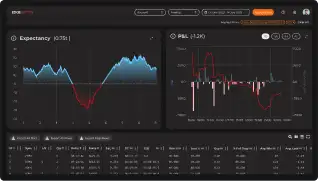
September 30,2024 @10:24 AM
Whether you review nightly statements, consider leasing or purchasing a seat, or choose the right data feed, you might wonder, “Why do some commodities on CME Group platforms say CME, while others carry labels like CBOT, NYMEX, or COMEX?” The history and origins of derivative’s trading in the U.S. explain this distinction. Before electronic trading, the comprehensive regulation, and modernization of the futures industry, there were mainly four exchanges that housed tradable products.
The Chicago Board of Trade
The Chicago Board of Trade (CBOT), founded in 1848, is the world’s oldest futures exchange. It created standardized contracts for agricultural commodities, known as “to-arrive contracts,” now recognized as forward and futures contracts. The Chicago Board of Trade came to prominence partly due to its central location for the Midwest and its farmland, along with being in the city that was a hub for the transportation of physical goods. To accommodate the growth and rise of interest the products traded they devised a scheme similar to a stadium with the center being a “pit”. This was called provision pits, where open-outcry trading took place—a tradition that is still maintained by the CME today. You can read more about the pits in our “Pits to Platforms” blog!
As the CBOT grew, the exchange diversified. They created the first debt futures for Ginne Mae, Treasury Bonds, and collaborated with Dow Jones to list Dow Futures. This evolution contributed to CME Group’s continued distinction within the industry. Standardizing contracts and centralizing locations reduced chaos and created order, improving on modern CFD or Forex trading environments.
Following the success of CBOT, other exchanges started to emerge, each addressing the unique needs of traders and producers.
The Chicago Mercantile Exchange
Another exchange that shortly followed was the Chicago Product Exchange, which was established in 1874. Initially, it was for the users and producers of physical goods such as butter and eggs that were sold on the spot at a stipulated price. This exchange was reorganized in 1898 and aptly renamed the Chicago Butter and Egg Board. They stored unsold products and introduced a selling method with a price agreed upon for delivery at a future date. This is another instance of the need and then the implementation for the security of markets.
Through diversification and expanded offerings, the exchange went through another rename which it still uses to this day, The Chicago Mercantile Exchange. Under the leadership of Chairman Leo Melamed, CME expanded its offerings, including the International Monetary Market. This market allowed for the trading of foreign currency futures, the eventual adaptation to stock index futures, as well as Eurodollar futures and Options, known today as SOFR futures and options, the most traded product on any of the CME Group Exchanges.
The New York Mercantile Exchange
In New York, The Butter and Cheese Exchange, renamed NYMEX in 1882, mirrored the CBOT and CME’s histories. It initially focused on agricultural products but shifted towards energy trading in response to the U.S. energy crisis of the 1970s. Light Sweet Crude, known officially as West Texas Intermediate or “CL” has the highest volume on the NYMEX. The initial contract that brought them into the energy space was Heating Oil.
The instability in energy prices presented NYMEX with the opportunity to transition to help users and producers reduce risks due to volatility. The success of this contract gave way for them to list Crude Oil futures and Natural Gas futures and cemented the NYMEX as the exchange for energy products.
While NYMEX solidified its dominance in energy markets, another exchange rose to prominence in metals trading.
The Commodity Exchange
The Commodity Exchange (COMEX) is the youngest of the 4 major exchanges and was founded in 1933 as the result of the merger of 4 smaller exchanges to centralize an exchange for primarily metals trading. Starting with industrial metals, COMEX expanded into precious metals like Gold and Silver in the 1970s and 1990s. In 1994, COMEX and NYMEX merged bringing energy and metals trading under the NYMEX while still operating as a separate division and keeping the core specialty of the exchange for metals trading.
The Shift to Electronic Trading
As each exchange grew, the bulk of trading shifted from open outcry in the pits to electronic trading through Globex. The exchanges found that rather than competing they could rely and work with one another to provide greater efficiencies on the market. The CME’s clearing division first agreed with CBOT to clear its products, and then both CME and NYMEX allowed their products to trade through the Globex platform. A few years later in 2007, the CBOT and CME agreed to merge and form the CME Group. The following year, the CME acquired NYMEX (which included COMEX) creating the CME Group as we know it today.
The Impact of Global Events on CME Group Exchanges
Global events and developments, from economic shifts to geopolitical tensions, have had a significant impact on the CME Group exchanges. Here, we will dive into how these major occurrences can impact the trading environment on each exchange. By examining these factors, we can gain a stronger understanding on how the CME Group adapts and evolves with the global landscape.
Economic Crises and Market Volatility
During times of uncertainty and increased volatility, market participants used products listed on the exchanges to hedge their exposure. The CME Group has responded by implementing measures to stabilize markets. These include enhancing margin requirements, setting price limits, the creation of smaller micro products, among others.
Geopolitical Events and Commodity Prices
Geopolitical events can disrupt global supply chains, causing significant fluctuations in commodity prices. Fluctuations in oil prices in response to geopolitical tensions in the Middle East can affect trading volumes in crude oil futures on NYMEX. Trade disputes and sanctions can also impact metal prices on COMEX. A recent example would be the Russia-Ukraine conflict. This geopolitical event has impacted global grain markets, with CBOT seeing increased trading activity in agricultural futures as market participants adjust their positions as a response to supply disruptions. Geopolitical issues are multifaceted and can create a ripple effect across multiple markets, affecting both supply and demand dynamics.
Technological Advances and Market Evolution
Technological innovations have transformed the futures trading markets. The introduction of Globex in the 1990s began the shift from open outcry to electronic trading. Another notable innovation is algorithmic trading. This has catapulted trading practices forward by allowing for high-frequency trades and sophisticated strategies.
It’s important to address that as technology evolves, so do the challenges. A large concern within the space is cybersecurity. CME Group has begun to invest in robust systems to protect traders against potential breaches. It is vital to safeguard traders against security threats so they can maintain market confidence and stability.
Regulatory Changes and Market Structure
Regulatory reforms have a lasting impact on the futures markets. From the pre CFTC Grain Futures and Onion Futures Act to the Commodity Exchange Act, the CME group has adapted to these changes by improving their reporting requirements and implementing new compliance measures.
The CME Group’s operations are also affected by global coordination among regulatory bodies. International standards and agreements can ensure market integrity across borders, supporting CME’s role as a leading global exchange.
The Modern Relevance of CME Group
Despite the consolidation, each exchange retained its specialty. This has allowed for the established histories of the different exchanges to remain trusted by traders all throughout the world. CBOT remains a hub for agricultural and debt futures, CME specializes in currency and index futures, NYMEX leads in energy markets, and COMEX remains key within metals trading. Traders established the specialization of these exchanges over a century ago, and it has evolved into highly liquid, global markets accessible around the globe.
The legacy of these historical exchanges have made an impact within the CME Group’s offerings. For example, many traders that are looking to hedge or speculate in agricultural markets often still think of CBOT as their go-to. The unique roles that each exchange has is still notable, contributing to the efficiency and trust within the markets they serve.
Reflection on Technology and Efficiency
The evolution of technology that introduced electronic trading through Globex was revolutionary. It not only increased the speed and accessibility of futures trading, but also facilitated a more global, 24-hour marketplace. What once called for physical presence on the trading floor is now possible from almost anywhere in the world digitally. This has expanded the amount of market participants, from institutions to retail traders, with access to these markets. The shift to electronic trading has expanded the markets, leading to greater liquidity, improved transparency, and faster execution.
Conclusion
From its humble beginnings with agricultural futures to becoming a powerhouse within modern futures trading, CME Group’s legacy is one of adaptation and innovation. Understanding the history behind the CME Group and its constituent exchanges offers traders a deeper appreciation for the products that they trade today. While times have changed since April 3, 1848, the CME has remained at the forefront of the financial industry, continuing to evolve and lead the way for traders around the globe.
~ Max Hessling, Commodity Broker

Contact Max Hessling
Disclaimer: The views expressed are personal opinions and should not be interpreted as financial advice.
